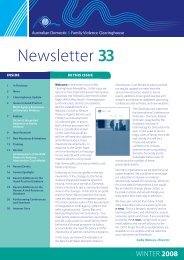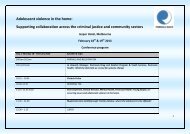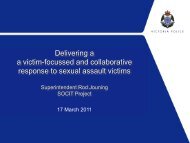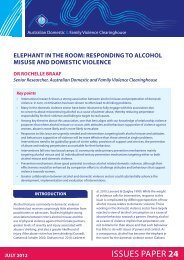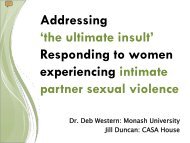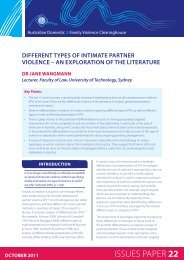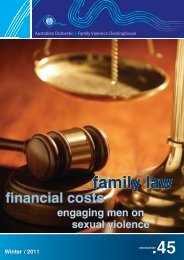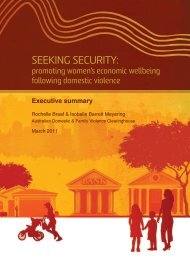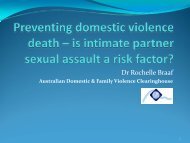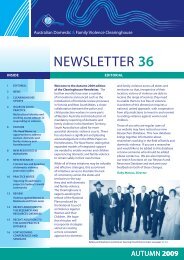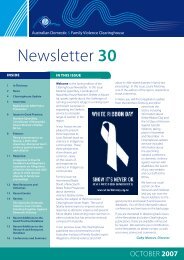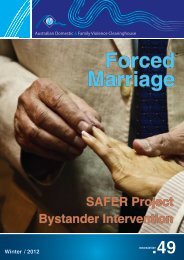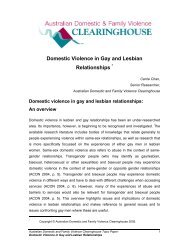Violence through our eyes - Women With Disabilities Australia
Violence through our eyes - Women With Disabilities Australia
Violence through our eyes - Women With Disabilities Australia
Create successful ePaper yourself
Turn your PDF publications into a flip-book with our unique Google optimized e-Paper software.
• the shame of marriage break down;<br />
• mistrust of outside assistance/ authorities;<br />
• lack of familiarity with <strong>Australia</strong>n service systems;<br />
• lack of culturally appropriate services; and<br />
• lack of knowledge of women’s rights under <strong>Australia</strong>n law.<br />
These difficulties are compounded for women who have Temporary Protection<br />
Visas (TPV). Some have experienced violence and persecution in their country of<br />
origin and then in the country of asylum. This may include family violence,<br />
violence within the community, targeted and generalised military violence, and/or<br />
violence in refugee camps.<br />
In addition, women with Temporary Protection Visas (TPVs) are entitled to very<br />
limited social security benefits. TPV refugees are paid a Social Security Benefit<br />
which is only 80% of the normal unemployment benefit. There are no additional<br />
benefits for people with disability and any money earned reduces the benefit paid<br />
on a dollar for dollar basis. While TPV holders are eligible to use the Job Network<br />
service at Centrelink, they are ineligible for the Work for the Dole scheme which<br />
provides local experience, Newstart, Sickness Allowance, Parenting Payment,<br />
Youth Allowance and Austudy.” (Refugee Council of <strong>Australia</strong> (2002).<br />
In response to lobbying about the vulnerability of women who are not permanent<br />
residents, the Federal Government introduced a provision under the Migration Act<br />
in 1991 to allow temporary residence visa holders who can provide evidence of<br />
violence by their partners to obtain permanent residence. However the provision<br />
is very limited. “Where charges of assault are brought against the abusive partner<br />
and the woman’s entry permit has expired, her residence status will remain in<br />
limbo pending an outcome. Resolution may take considerable time and in the<br />
interim she may be without financial support.” (<strong>Australia</strong>n Law Reform<br />
Commission, 2004, Vol. 69, Ch 10)<br />
<strong>Violence</strong> against <strong>Women</strong> with Disability and Carers<br />
“<strong>Violence</strong> against women with disabilities refers to a wide range of abuses, both<br />
individual and systemic. <strong>Women</strong> with disabilities experience many different types<br />
of abuse, some of which are unique to women with disabilities. For example,<br />
sexual abuse of a woman with disability may include forced sterilization or forced<br />
abortion. Physical abuse may include taking away a woman’s wheelchair, or<br />
bathing an individual in very hot or cold water, it could involve rearranging the<br />
physical environment which then increases risk of personal harm. Not only are<br />
women with disabilities at greater risk for abuse, but also let’s not forget that<br />
abuse can be the cause of the disability” (C. Jennings, Domestic <strong>Violence</strong> and<br />
Incest Centre, 2003).<br />
Research suggests that women with disability are 2 to 12 times more likely to<br />
experience physical and sexual violence than other women. The main reasons<br />
are poverty; segregation; low rates of education and employment; dependence on<br />
carers; social isolation; perceived powerlessness; and society’s denial that women<br />
with disabilities are targets of violence.<br />
<strong>Violence</strong> <strong>through</strong> <strong>our</strong> <strong>eyes</strong> 24



